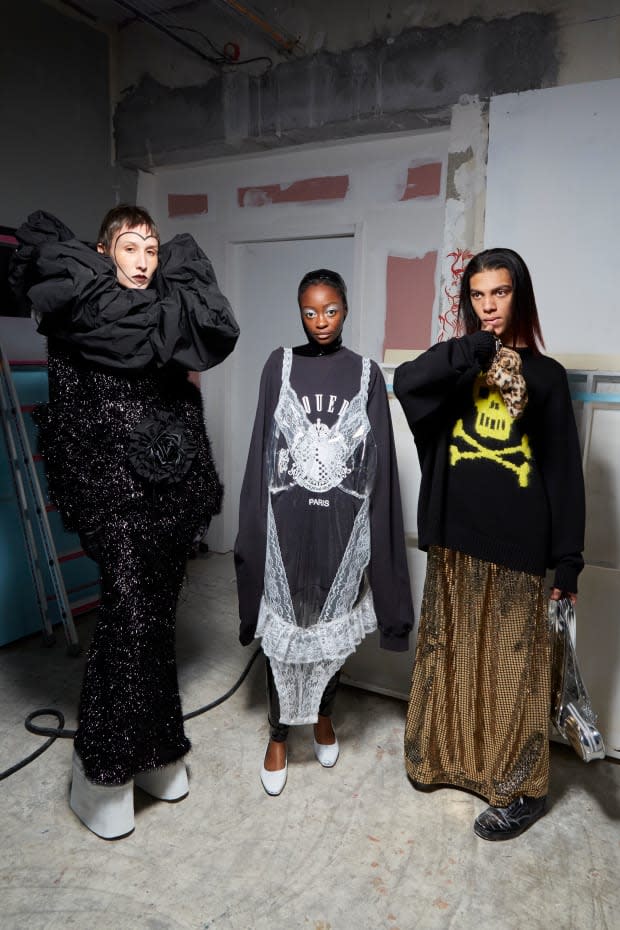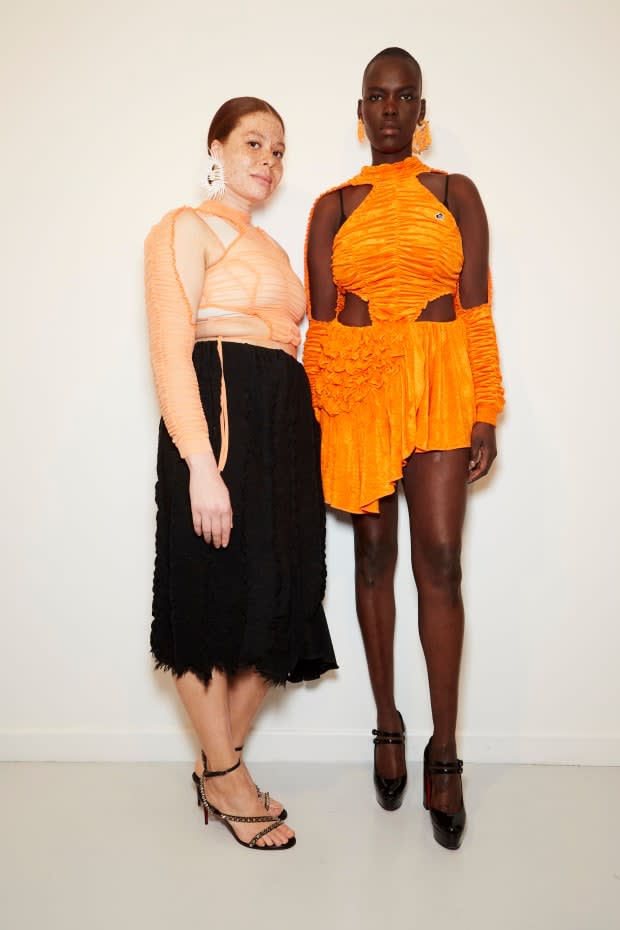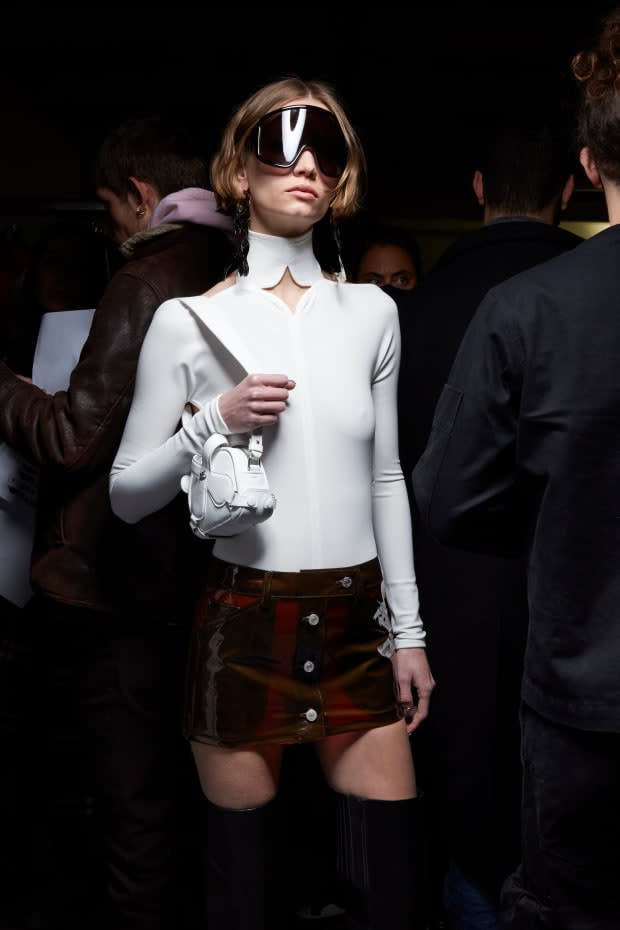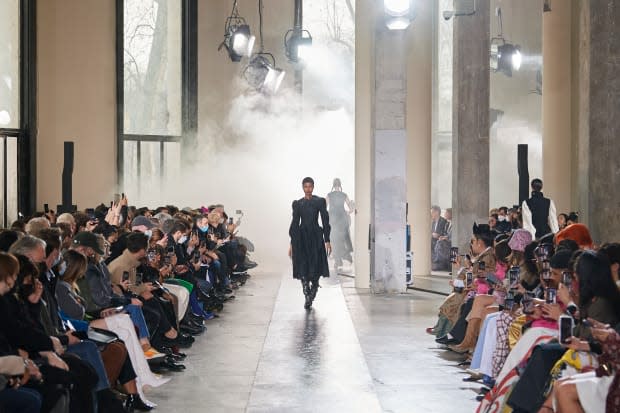A New Generation of Creative Thinkers Is Changing Paris Fashion Week
"These designers stay true to their own voices instead of conforming. They don't try to grow by distorting their message — they push themselves to make it louder."
Paris is the home of the world's historically eminent luxury maisons, but in recent seasons, newer names have begun staking their claim in the French capital's fashion scene.
Unlike the brands that act as the linchpins of Paris Fashion Week, the new wave is mobilizing the next generation with their musings on society's most timely, pressing themes. From Vaquera's spiky, confrontational creativity to Ludovic de Saint Sernin's soft-porn aesthetic presenting a paean to sexual liberation and gender fluidity; Ester Manas' game-changing push for body diversity on the runway and the revival of legendary houses like Courrèges and Rochas with young creatives at the helm, new blood is electrifying Paris.
"What the designers have in common is not just creativity, but a commitment to a vision of the world which, compared to 20 years ago, is very different," Serge Carreira, head of the Emerging Designers Initiative at the Fédération de la Haute Couture et de la Mode — which governs Paris Fashion Week — says. "Of course, design is always a mirror to culture and society, but they're directly contributing to change. They're finding their own way and their own voice, reflecting the world through their different preoccupations."
Julie Gilhart, a fashion consultant and the chief development officer of brand accelerator Tomorrow Ltd., points to brands like Botter and Rokh, which present ideas that push the fashion landscape forward as a whole. "Larger brands are definitely addressing some topics, but these brands have an assertiveness that larger brands don't have as much," she says. "They're bringing an energy that reflects them."

Photo: Imaxtree
Like Vetements before them, Patric DiCaprio and Bryn Taubansee of Vaquera set the city alight, arriving from New York with a rogue sensibility and a desire to translate the brand's non-conformist spirit for a new audience. Vaquera's first two collections in Paris had a punk-inspired streak, with fetish details, oversized knits and sheer fabrics, the result inspired but never hackneyed, a renegade spirit that feels utterly contemporary in a week that sees luxury performed to the umpteenth degree. Its vision — with brazen, glowering models thundering down the catwalk — blows raspberries in the establishment's face.
Ludovic de Saint Sernin is similarly rewriting the codes of luxury. While the designer's material choices, like wool from Loro Piana and louche chiffon, feed into institutional expectations, his throbbingly sexual approach to dressing stirs an often neutered fashion sphere. Lean silhouettes in tonal hues might be sensual in the hands of most, but de Saint Sernin has a propensity for the sultry — shimmering crystal bodices, skin-tight mini-dresses, scantily-clad men that look like they've stepped out of a Tom Ford for Gucci campaign.
It isn't to say his work is derivative: Its steamy provocation reaches beyond the past and into new territory. He approaches masculinity with an impressive tenderness; femininity is treated the exact same. The body is a canvas for sexual expression, and as conservative streaks run amok across the world, de Saint Sernin shows how clothing (the little of it that's often there) can be a tool for expressing sexuality.
Another jolt to the system, Ester Manas challenges the status quo of casting at European fashion weeks with an inclusive attitude towards body diversity. Each garment is originally fitted on co-founder Ester Manas herself, the stretchy fabrics designed to accommodate many sizes. While size diversity among models has received more attention over the past years, founders Manas and Balthazar Delepierre have expressed displeasure with how it rarely translates into retail, where larger customers are still sized out by the industry's archaic standards.

Photo: Imaxtree
As with anything in fashion, the extent to which labels have a cool caché predetermines their success. But nowadays, the word "cool" has become somewhat diluted, the qualities that warrant the descriptor pillaged by creative frauds and wannabes. Yet, looking at Arnaud Vaillant and Sebastien Meyer's collections for Coperni, one gets the sense that hope lingers. From tailoring to mini dresses and denim — the currency the duo trades in — there are updates that propel staples into the future, targeting Gen Z with the help of faces like Lila Moss, Paloma Elsesser and Bella Hadid. Coperni Cool is a way forward for fashion.
Elsewhere in Paris, heritage French brands are at the juncture of legacy and future, with newly-appointed creative directors proposing fresh interpretations of style.
Installed at Rochas, 25-year-old Charles de Vilmorin has a flair for coupling dramatic exuberance with lighthearted, playful feminine shapes, alongside some sweeping, dark, transgressive renditions of romanticism for the the 97-year-old house. In contrast, Nicolas Di Felice's Courrèges is propelling the brand into its next chapter (and beyond) by maintaining its Space Age unfussy simplicity, unmodest harshness and undeniable sexiness (think kittle white dresses, gabardine skirts, bodycon basics, vinyl jackets), with flexible with interpretations of gender. Expect more to come on Thursday morning at the latter's Spring 2023 debut, where clothes that we typically associate with nighttime will likely proceed down the runway.
"You can't just look at the show, but what happens around it — he's engaging who he feels like is his audience by going directly to them," says Amy Verner, a Paris-based writer and journalist, citing Courrèges' Pride capsule with proceeds going towards No Drama, a social platform for the queer community in Paris. "It doesn't seem like marketing; he's just doing things that he thinks they would like. It's never obvious or performative. It's intrinsic to the identity he's creating for the brand."

Photo: Imaxtree
de Vilmorin's Spring 2023 for Rochas is lighter, replete with simple, practical fabrics like cotton and denim, alongside more glamorous organza. Hammered and plissé lamé silks recall the house's luxurious origins, the designer's touch showing shades of Galliano and McQueen. De Vilmorin hopes to "show another aspect of the brand" with this collection, he says ahead of the show on Wednesday. "It's less about sophistication and more conceptual, but still very chic." Customers that have been with Rochas for decades still have a seat reserved for them, but with new blood comes new ideas — and, in turn, a new prospective client base.
The challenge with communicating new ideas about style and aesthetics in fashion, particularly in Paris, is the proximity in which young designers' shows are positioned in relation to the megabrands, with their legacies, global fan bases and advertising dollars. While most of the new crop have startling ideas and are constantly fine-tuning their output, their efforts are often attenuated by the industry titans' financial composition.
"They all have their marketing story down, and they're delivering on that part, but there's so much more," Gilhart says. "If you want to be successful, that has to be delivered. We're talking about supply chain, the people behind the company, how they address the materials or merchandising. It's very difficult for young designers to do on their own."
This was documented in Matthew Schneier's 2018 profile of Vaquera in The New York Times. If it wasn't for support from Dover Street Market Paris' emerging designer incubator, the brand's fate might've been muddled, its ideas a tragic blink in time.
Tomorrow Ltd has invested in Coperni, and assists Ester Manas in showroom capacities. Rochas and Courrèges, too, require investment and wholesale help to restore the names to former glory.

Photo: Imaxtree
The financial might of a company often impacts the dissemination of diverse storytelling. True diversity — of body, sexuality, gender, age — is often sidelined by industry juggernauts who moonlight as activists to peddle leather goods and fragrances and make lucrative profit margins. The real game-changers, their gumption and honesty, can get overlooked.
However, with an increasingly alert base of loyal fans, millennial and post-millennial designers utilize tools like social media with aplomb, garnering new followers as their brands and voices develop. Many large luxury brands yearn to chase upcoming generations, but it's the likes of Coperni and Ester Manas and other digital natives that do it best.
With the future bright for Paris, expect to be wowed by Weinsanto's theatrics and inclusive casting, Germanier's unwavering loyalty to sustainable craftsmanship, Nix Lecourt Mansion's unabashedly sultry wares, the gothic fluidity of Pressiat. The ascendant stars of Paris Fashion Week — each with a preoccupation that revolves around shifting societal mores — aren't just getting started: They're multiplying.
"These groups of people have never been spoken to so pointedly in fashion," Gilhart says.
Verner agrees, arguing that the vision shared by this new crop "is not about tokenism or signaling. There might be a strategy behind it, or it might be deliberation, but in the execution, it never feels like it."
It illuminates the question: If Paris Fashion Week is the nexus of fashion, are these ascendant creatives that increasingly grab our attention the glue that binds it together? The Paris tradition has long been a cocktail of local and international names, tradition and modernity; now, more than ever, young designers are telegraphing much-needed visual posits on the body, gender, sexuality, politics and style. To each, their own singular vantage point; with each season, they communicate more coherently.
"These designers stay true to their own voices instead of conforming," says Carreira. "They don't try to grow by distorting their message — they push themselves to make it louder."
Never miss the latest fashion industry news. Sign up for the Fashionista daily newsletter.
